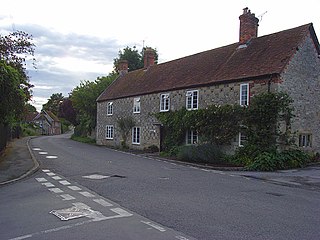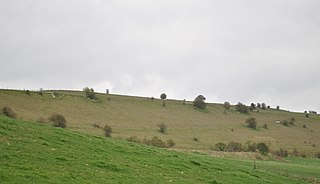
Wiltshire is a historic county located in the South West England region. Wiltshire is landlocked and is in the east of the region.

Barford St Martin is a village and civil parish in Wiltshire, England, about 2.5 miles (4 km) west of Wilton, around the junction of the A30 and the B3089. Barford is known as one of the Nadder Valley villages, named for the River Nadder which flows through the parish.

Savernake Forest stands on a Cretaceous chalk plateau between Marlborough and Great Bedwyn in Wiltshire, England. Its area is approximately 4,500 acres.

The River Wylye is a chalk stream in the south of England, with clear water flowing over gravel. It is popular with anglers for fly fishing. A half-mile stretch of the river and three lakes in Warminster are a local nature reserve.

Wylye is a village and civil parish on the River Wylye in Wiltshire, England. The village is about 9+1⁄2 miles (15 km) northwest of Salisbury and a similar distance southeast of Warminster.

Burcombe is a village in the civil parish of Burcombe Without, in Wiltshire, England. The village is about 4.5 miles (7 km) west of Salisbury city centre and lies each side of an unclassified road. Burcombe is an unspoiled village with many of the houses' gardens leading down to the River Nadder. The parish includes the hamlet of Ugford which is on the A30 road near the boundary with Wilton parish.

Upton Lovell is a village and civil parish in Wiltshire, England. It lies on the A36, in the Wylye valley about 5 miles (8.0 km) southeast of Warminster. The parish is on the left (northeast) bank of the river, and stretches for over two miles northeast onto Salisbury Plain.

The River Nadder is a tributary of the River Avon, flowing in south Wiltshire, England.

The Wiltshire Victoria County History, properly called The Victoria History of the County of Wiltshire but commonly referred to as VCH Wiltshire, is an encyclopaedic history of the county of Wiltshire in England. It forms part of the overall Victoria County History of England founded in 1899 in honour of Queen Victoria. With eighteen volumes published in the series, it is now the most substantial of the Victoria County Histories.

Stockton is a small village and civil parish in the Wylye Valley in Wiltshire, England, about 8 miles (13 km) southeast of Warminster. The parish includes the hamlet of Bapton.
The Salisbury branch line of the Great Western Railway from Westbury to Salisbury in Wiltshire, England, was completed in 1856. Most of the smaller stations were closed in 1955 but the line remains in use as part of the Wessex Main Line.

Great Wishford is a village and civil parish in the Wylye Valley in Wiltshire, England, about three miles (5 km) north of Wilton and five miles (8 km) northwest of Salisbury. The village lies west of a bend in the River Wylye and has a triangular street layout comprising South Street, West Street and Station Road.

Steeple Langford is a village and civil parish in the English county of Wiltshire, 6 miles (10 km) northwest of Wilton. It has also been called Great Langford or Langford Magna. The village lies on the north bank of the River Wylye, and is bypassed to the north by the A36 Warminster-Salisbury trunk road which follows the river valley.

Great Ridge Wood, formerly also known as Chicklade Wood, is one of the largest woodlands in southern Wiltshire, England. Mostly within the parishes of Boyton and Sherrington, and entirely within the Cranborne Chase and West Wiltshire Downs Area of Outstanding Natural Beauty, it lies on a chalk downland ridge above the River Wylye. To the south are the villages of Chicklade and Fonthill Bishop, while to the north are Boyton, Corton, Sherrington and Stockton. To the east of the wood, on the same ridge, lies another large block of woodland, Grovely Wood.

South Newton is a village and civil parish about 4 miles (6.4 km) north-west of Salisbury in Wiltshire, England. Topologically it lies between chalk downs to the north-east, and downland with Grovely Wood to the south-west. The village straddles the A36 road and is on the left bank of the River Wylye, which defines much of the western boundary of the parish; the eastern boundary follows the A360 Salisbury-Devizes road.

Little Langford is a hamlet and former civil parish, now in the parish of Steeple Langford, in Wiltshire, England. Its nearest town is Wilton, about 5 miles (8.0 km) to the southeast. It is in the Wylye valley, to the south of the river; the grass fields adjacent to the river were traditionally flood meadows. In 1931 the parish had a population of 64. On 1 April 1932 the parish was abolished and merged with Steeple Langford.

The site of Ebsbury, in Wiltshire, England, includes the remains of an Iron Age enclosed settlement, field system and possible hill fort, and a Romano-British enclosed settlement.

Grovely Castle is the site of an Iron Age univallate hill fort in the parish of Steeple Langford, in Wiltshire, England. The remaining ramparts stand approximately 3.2 m (10 ft) high, with 1.5 m (4.9 ft) deep ditches, although ploughing has damaged the earthworks in some parts of the site. Excavations have uncovered the remains of five human skeletons within the ramparts. Entrances are in the south-west and north-east corners of the hillfort. A circular enclosure of 35 to 40 m is evident in aerial photographs of the hillfort interior. There is also a later bank and ditch which runs through the hill-fort from south-west to north-east, and is probably part of an extensive surrounding Celtic field system.

















